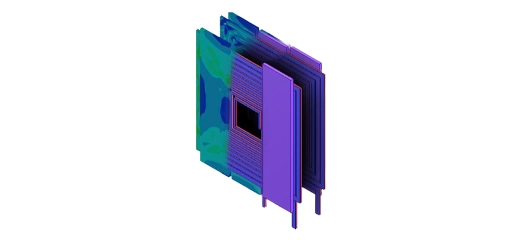Motion Coupling
Motion Coupling in EMWORKS
Motion coupling is a powerful feature that enhances the accessibility of EMWORKS’ suite of electromagnetic simulation products. It allows engineers to seamlessly integrate electromagnetic field analysis with the mechanical motion of components or systems. This capability is especially valuable for devices with dynamic or moving parts, such as motors, actuators, transformers, and sensors. By combining electromagnetic and mechanical simulations, EMWORKS ensures accurate, efficient designs while making advanced simulation tools more approachable for engineers and designers.
How Motion Coupling Works
Motion coupling works by allowing users to define the motion and displacement of objects or parts within their electromagnetic simulations. This means that you can analyze how the electromagnetic fields interact with the moving components and vice versa. For example, in a motor design, you can simulate how the changing position of the rotor affects the magnetic field distribution and, consequently, the motor's performance.
Key Benefits of EMWORKS' Motion Coupling
Realistic Simulations
Motion coupling adds a layer of realism to simulations by accounting for the dynamic behavior of components. This results in more accurate predictions and insights.
Optimization
Engineers can use motion coupling to optimize both the mechanical and electromagnetic aspects of a device simultaneously. This leads to better overall design performance.
Comprehensive Analysis
With motion coupling, you can analyze a wide range of electromechanical systems, including linear and rotary actuators, transformers with movable cores, and devices with sliding or rotating parts.
Understanding Complex Interactions
In devices where the electromagnetic and mechanical components are intricately linked, motion coupling helps in understanding how changes in one aspect affect the other.
Multi-Physics Simulations
EMWORKS' motion coupling capabilities extend to multi-physics simulations, allowing engineers to consider electrical, magnetic, thermal, and mechanical interactions in a single simulation environment.
Applications of EMWORKS' Motion Coupling
Motion coupling is a versatile technique that finds applications across various industries and devices, enabling engineers and researchers to gain deeper insights into the interaction between electromagnetic fields and mechanical motion. Some prominent applications of motion coupling include
Electric Motors
Motion coupling allows engineers to analyze motor performance in the context of rotor movement and magnetic field changes. This analysis is crucial for optimizing motor efficiency, reducing losses, and ensuring smooth operation in applications ranging from industrial machinery to electric vehicles.
Solenoids
Understanding the impact of solenoid plunger motion on magnetic force and coil behavior is essential for designing efficient solenoid systems. Motion coupling enables the precise modeling of solenoid performance, aiding in applications such as automotive fuel injection systems, locking mechanisms, and pneumatic control valves.
Transformers
In transformers, the core's mechanical motion can have a significant impact on energy transfer and losses. Motion coupling simulations help engineers assess the effects of core movement, optimizing transformer designs for improved efficiency and reliability in power distribution networks and electrical systems.
Actuators
Linear and rotary actuators play a crucial role in various industries, including robotics, aerospace, and automotive. Motion coupling analysis allows engineers to study the response of these actuators to electromagnetic forces, ensuring precise and efficient motion control in diverse applications.
Sensors
Many sensors, such as Hall-effect sensors and magnetostrictive sensors, rely on magnetic field variations to detect changes in their surroundings. Motion coupling enables researchers to investigate the effect of sensor movement on sensitivity and accuracy, ensuring reliable sensor performance in applications like automotive position sensing and industrial automation.
Switches and Relays
Electromagnetic switches and relays with movable contacts are used extensively in control systems and power distribution. Motion coupling simulations help optimize the operation of these devices by considering the mechanical motion of contacts, ensuring reliable switching and reduced wear and tear.
Electromagnetic Brakes and Clutches
Motion coupling is valuable for analyzing the behavior of electromagnetic brakes and clutches, which rely on the interaction between magnetic fields and mechanical motion to control engagement and disengagement. This analysis aids in designing efficient braking and clutch systems for automotive transmissions, industrial machinery, and robotics.
Magnetic Levitation Systems
Magnetic levitation (maglev) systems, used in transportation and material handling, utilize the interaction between magnetic fields and objects to achieve frictionless motion. Motion coupling simulations help optimize the magnetic levitation forces, ensuring stable and efficient operation in maglev trains, magnetic conveyors, and levitating platforms.
Electromagnetic Actuated Valves
Motion coupling is essential for evaluating the performance of electromagnetic actuated valves used in fluid control systems. It enables engineers to assess how valve motion affects fluid flow and pressure, optimizing valve designs for applications such as automotive fuel injection, industrial process control, and medical devices.
Magnetic Resonance Imaging (MRI)
In medical imaging, MRI machines rely on precise control of magnetic fields to produce high-quality images. Motion coupling analysis helps ensure that motion, such as patient movement or adjustments to imaging coils, does not compromise imaging accuracy, contributing to improved diagnosis and patient care.
Electromagnetic Launch Systems
Electromagnetic launch systems, including railguns and coilguns, use electromagnetic forces to accelerate projectiles. Motion coupling simulations assist in optimizing the design of launchers, ensuring efficient projectile acceleration and trajectory control for military and space launch applications.
These diverse applications highlight the versatility of motion coupling techniques in optimizing the performance, efficiency, and safety of electromagnetic systems across various industries. Engineers and researchers continue to leverage motion coupling to address complex challenges and advance technology in fields ranging from transportation and healthcare to manufacturing and energy.



